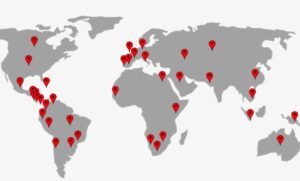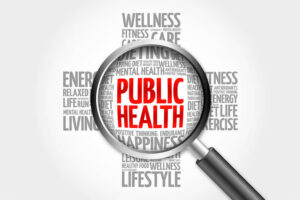Innovations and developments in Malaria
Malaria continues to pose significant global health challenges despite advances in medical science. This special theme issue examines the dual aspects of the ongoing battle against malaria: the persistent hurdles that impede eradication efforts and the innovative opportunities that are emerging in prevention, treatment, and control strategies. It highlights the collaborative efforts required to combat this disease, from the development of more effective drugs and vaccines to the implementation of sustainable public health policies. By bringing together research findings, expert opinions, and case studies, this issue aims to inspire a concerted effort towards a future where malaria is no longer a threat to human health and well-being.
Wamae PM
Climate and Human Health Research Unit, Centre for Global Health Research, Kenya Medical Research Institute (KEMRI). P.O Box 1578-40100 Kisumu, Kenya; Department of Community Health, School of Public Health, Kenyatta University. P.O Box 43844-00100 Nairobi, Kenya
Otieno GO
Department of Community Health, School of Public Health, Kenyatta University. P.O Box 43844-00100 Nairobi, Kenya
Kabiru EW
Department of Community Health, School of Public Health, Kenyatta University. P.O Box 43844-00100 Nairobi, Kenya
Munga S
Division of Malaria Control (DOMC), Ministry of Public Health and Sanitation, Kenya. P.O Box 19982-00202 Nairobi, Kenya
Kibet SJ
Division of Malaria Control (DOMC), Ministry of Public Health and Sanitation, Kenya. P.O Box 19982-00202 Nairobi, Kenya
Duombia SO
Malaria Research and Training Centre, Faculty of Medicine. University of Mali, Bamako. P.O Box 1805 Bamako, Mali
Githeko AK
Climate and Human Health Research Unit, Centre for Global Health Research, Kenya Medical Research Institute (KEMRI). P.O Box 1578-40100 Kisumu, Kenya
Abstract
Malaria heterogeneity in the highlands is due to range of factors including seasonal weather changes, climate variability, land-use changes, topography, drug resistance, and malaria control programs. High coverage of long lasting insecticide treated nets is the basis of vector control in epidemic prone western Kenya highlands. Long lasting insecticide treated nets have effectively controlled malaria in the hypo-endemic zones, but not in meso-endemic and hyper-endemic zones where significant residue of transmission remains despite control efforts.
Inadequate policy on integrated vector management application for ecologically heterogeneous ecosystems hinders effective malaria control. Advances in ecological and epidemiological studies have improved our understanding on vector distribution determinants and malaria transmission enabling us to effectively integrate indoor residual spraying into the existing long lasting insecticide treated nets programme.
Data on malaria vector abundance and parasite prevalence for different malaria ecosystems within western Kenya highlands before and after mass insecticide treated bed-net distribution campaigns was gathered to assess the efficacy of the long lasting insecticide treated nets based control efforts. Field tests were carried out to determine the impact of combined indoor residual spray and long lasting insecticide treated nets on vector indoor resting densities in zones where insecticide treated nets alone had limited efficacy or zero efficacy was observed.
Female An. gambiae s.l resting densities of 0.1 mosquitoes/ house/night were associated with a plasmodium falciparum (pf) prevalence rate of 10% or below. This observation enabled the development of a framework for the inclusion of indoor residual spray in integrated vector management with the suggestion that IRS should be applied in malaria eco-epidemiological zones where An. gambiae s.l resting densities exceeds 0.1 females/ house/ night.
Similarly, only those houses with a resting density of 0.1 females An. gambiae s.l and above should be targeted during spraying. Such an approach would significantly reduce the cost associated with indoor residual spray and provides a rationale for judicious integration of indoor residual spray within existing long lasting insecticide treated nets control programmes.
Mukuma lubinda
Macha Research Trust, Choma District, P.O Box 630166, Zambia.
Japhet Matoba
Macha Research Trust, Choma District, P.O Box 630166, Zambia.
Caison Sing’anga
Macha Research Trust, Choma District, P.O Box 630166, Zambia.
Emmanuel G. Meleki
Ministry of Health, Southern Provincial Health Office, Choma, Zambia.
Rakel Maketo Mukosha
Ministry of Health, Choma District Health Office, Choma, Zambia.
Twig Mudenda
Macha Research Trust, Choma District, P.O Box 630166, Zambia.
Limonty Simubali
Macha Research Trust, Choma District, P.O Box 630166, Zambia.
Monicah M. Mburu
Macha Research Trust, Choma District, P.O Box 630166, Zambia.
Edgar Simulundu
Macha Research Trust, Choma District, P.O Box 630166, Zambia.
Phillip E. Thuma
Macha Research Trust, Choma District, P.O Box 630166, Zambia.
Clive Shiff
Department of Molecular Microbiology and Immunology, Johns Hopkins Bloomberg School of Public Health, Baltimore, MD 21205, USA
Abstract
The Southern Province of Zambia has been afflicted with malaria for many years, but in recent times, with the success of the national malaria control programme, malaria transmission has declined significantly and is now at low ebb. This success has been attributed to the effective use of indoor residual spraying, proper use of insecticide-treated mosquito nets provided to the people, as well as the use of artemisinin combination therapies in all rural health centres (RHCs) to treat clinical malaria cases at health facilities as well as in the communities by trained community health workers (CHWs). Despite this success and in trying to understand the epidemiology and control of malaria in rural areas of sub-Saharan Africa, it has been clear that local elimination is most unlikely due many challenges such as lack of incentives for CHWs who are the first link of the community to the health care system, inability of the officially approved rapid diagnostic tests to detect low level parasitemia in asymptomatic individuals, and anti-malaria stock-outs in RHCs, especially during the rainy season when most areas are unreachable due to impassable roads. This paper discusses the role of RHCs in the detection and management of malaria outbreaks in low transmission settings and the challenges of achieving elimination in Choma District, Southern Province, Zambia. These challenges could adversely impact malaria elimination if they remain unanswered.
Yukie M. Lloyd
Department of Tropical Medicine, Medical Microbiology and Pharmacology, John A. Burns School of Medicine, University of Hawaii at Manoa, Hawaii, USA
Naveen Bobbili
Department of Tropical Medicine, Medical Microbiology and Pharmacology, John A. Burns School of Medicine, University of Hawaii at Manoa, Hawaii, USA
Ali Salanti
Centre for Medical Parasitology, Department of Immunology and Microbiology, University of Copenhagen, Denmark; Department of Infectious Diseases, Copenhagen University Hospital, Denmark
Philomina Gwanmesia
Faculty of Medicine and Biomedical Sciences, Biotechnology Centre, University of Yaoundé I, Yaoundé, Cameroon
Josephine Fogako
Faculty of Medicine and Biomedical Sciences, Biotechnology Centre, University of Yaoundé I, Yaoundé, Cameroon
Rose F.G Leke
Faculty of Medicine and Biomedical Sciences, Biotechnology Centre, University of Yaoundé I, Yaoundé, Cameroon
Diane W Taylor
Department of Tropical Medicine, Medical Microbiology and Pharmacology, John A. Burns School of Medicine, University of Hawaii at Manoa, Hawaii, USA
Abstract
Background: Women produce antibodies to VAR2CSA when infected with Plasmodium falciparum during pregnancy that reduce disease severity in the current and subsequent pregnancies. In addition to antibody quantity, antibody quality (e.g., avidity) and function (e.g., inhibition of binding and opsonic phagocytosis) are immunologically important. Studies comparing the quantity, avidity and effector mechanisms of antibodies to VAR2CSA in the same group of women with pregnancy outcomes, especially in low transmission areas, are limited.
Aims: The purpose of this study was to characterize antibodies to VAR2CSA using four assays, determine the correlation among the assays, and relate this to pregnancy outcome.
Methods: A panel of 310 plasma samples from women in Yaoundé (a city with low malaria transmission) who had antibodies to full-length VAR2CSA were screened in assays that measured i) level of antibodies to VAR2CSA, ii) antibody avidity, iii) reduction in binding (RiB) of fluorescent VAR2CSA-coupled beads to fluorescent-CSA-coupled beads, and iv) opsonic phagocytosis using VAR2CSA-coupled beads and human THP1 cells. Results from the assays were compared with clinical information from 614 women who were Ab-negative.
Results: A modest association was found among the 4 assays, i.e., as the amount of antibodies increased, a small increase in avidity, RiB and phagocytosis was observed; however, the association between RiB and avidity was poor. When results were dichotomized to above and below the median, antibody avidity, but not antibodies in the other assays, was associated with a significant reduction in prevalence of placental malaria and lower placental parasitemia. However, women who had antibody values above the median in amount (p=0.03), avidity (p=0.006), reduction in binding (p=0.018) and probably phagocytosis (p=0.065) had significantly lower placental parasitemia than women who lacked Abs to VAR2CSA.
Conclusions: In this urban setting, women with the highest (above the median) antibody levels, in the four assays had a lower prevalence of placental malaria and placental parasitemia than women who lacked anti-VAR2CSA antibodies. Thus, VAR2CA-based vaccine trials in low transmission areas should consider using all four assays before and after vaccination.
El Khahouri I
Department of Intensive Care Medicine, Ibn Rochd University Hospital, Faculty of medicine and Pharmacy of Casablanca, Hassan 2 University, Casablanca, Morocco.
Tougar S
Department of Intensive Care Medicine, Ibn Rochd University Hospital, Faculty of medicine and Pharmacy of Casablanca, Hassan 2 University, Casablanca, Morocco.
Maghrabi O
Department of Intensive Care Medicine, Ibn Rochd University Hospital, Faculty of medicine and Pharmacy of Casablanca, Hassan 2 University, Casablanca, Morocco.
Mashrouh W
Department of Intensive Care Medicine, Ibn Rochd University Hospital, Faculty of medicine and Pharmacy of Casablanca, Hassan 2 University, Casablanca, Morocco.
Mabchour M
Department of Intensive Care Medicine, Ibn Rochd University Hospital, Faculty of medicine and Pharmacy of Casablanca, Hassan 2 University, Casablanca, Morocco.
Mabchour M
Department of Intensive Care Medicine, Ibn Rochd University Hospital, Faculty of medicine and Pharmacy of Casablanca, Hassan 2 University, Casablanca, Morocco.
Charra B
Department of Intensive Care Medicine, Ibn Rochd University Hospital, Faculty of medicine and Pharmacy of Casablanca, Hassan 2 University, Casablanca, Morocco.
Abstract
Cerebral malaria, one of the most serious complications of Plasmodium falciparum infection, is characterized by the sequestration of parasitized red blood cells (HP) within deep cerebral microvessels. Herein, we report the case of a 30-year-old man with no particular medical history, with the notion of stay in an endemic area [Ivory Coast] for 3 months. , who was admitted to our medical intensive care unit for status epilepticus. Upon admission the patient was immediately intubated due to persistent seizures. He was febrile at 39°C. Lumbar puncture was performed and was sterile. A cerebral CT showed a slight cerebral edema with exaggerated hyper density of the cerebral tent. A cerebral MRI showed a hypersignal of selenium from the corpus callosum, corresponding to a hematoma of the corpus callosum which subsequently revealed an imported neuroma aria. A thick blood smear was then performed, showing the presence of plasmodium falciparum trophozoites, following which the patient was put on Artesunate. The evolution was favorable,and the patient was extubated without neurological complications .We also point out the challenges this diagnosis may pose, especially in a non-endemic country such as Morocco.
Christopher K. Williams, MD FRCPC
Abstract
The African environment has for millennia been dominated by rampant agents of infections, of which malaria is among the best known, virtually uncontrolled, and associated with lifelong human struggles, ameliorarated by measures as socioeconomicaly affordable. This has led to the emergence of a variety of genetic aberrations, some of which are deleterious, resulting in major disease dysparities, including benign ones like sickle cell disease, and malignancies like the leukaemias, lymphomas, and breast cancer. They include the reduced incidence and the absence of its peak in acute lymphoblastic leukaemia in the first quinquennium of Nigerian children, which is otherwise typically seen in the children of high-income countries. Conversely is the observation in acute myelogenous leukaemia, with its chloroma-associated variant and its incidence peaking in the second quinquennium. This epidemiology is akin to the recent observation of acute myelogenous leukemia among sickle cell disease patients among the people of African descent in California, USA. Chloroma-associated acute myelogenous leukemia, and Burkitt lymphoma are linked with low socioeconomic status, an epidemiological feature that is shared with triple negative breast cancer patients in West Africa and the women of African descent in the United States. While a role for the malaria-associated genetic aberration underlying the Duffy null genotype is confirmed in the diversity of the triple negative breast cancer in the women of West Africa and those of African descent in the United States, it is conceivable, but not yet established in acute myelogenous leukemia. The zoonosis-linked human T-cell lymphotropic virus type 1 infection is associated with at least 17% of non-BL-non-Hodgkin lymphoma in form of its sentinel disease, the adult T-lymphoma/leukemia, but unexpicably much lower than the 50-60% of other major endemic zones of Japan and the African descendants of the Caribeean. This report describes the clinical, laboratory, and epidemiological features of leukemia and lymphoma cases diagnosed between 1982 and 1984 in the city of Ibadan, Nigeria, some of the features of which are reminiscent of the observations of Ludwig Gross’s experiments on environmental influences, such as malnutrition and infections, on animal leukemogenesis. These events are the consequences of the primordial pressures that have shaped human genetics and pathophysiology. Evidence provided in this study, indicating association of increasing socioeconomic status with increasing frequency of the c-ALL subtype, is indicative of the prospects for leukemogenesis of acute lymphoblastic leukemia and its epidemiology in Nigerians. Some findings reported here indicate the influence of the African genetic ancestry in the etiology of acute myelogenous leukemia, while socioecomic status is linked to the etiology of childhood acute lymphoblastic leukemia, as well as a variant of chronic lymphocytic leukemia, and the chloroma-associated acute myelogenous leukemia. These observations are suggestive of the existence of pathways to etiological discoveries in the leukemias. Observations reviewed in this paper reflect examples of changes that have occurred over the past 200 years in the societal perception of health challenges among the new-found communities of colonial Africa and the Americas – from the reductionistic connotations such as in the “virgin-soil theory” – towards that of social determinants of health.
Mocket Adolphe Ehouman
Olopam Pharma and Research & Development, 10 BP 1274 Abidjan 10, Côte d’Ivoire; Unité de Formation et de Recherche Biosciences, Université Félix Houphouët-Boigny, 22 BP 770, Abidjan 22, Côte d’Ivoire.
Kouakou Eliezer Ngoran
Unité de Formation et de Recherche Biosciences, Université Félix Houphouët-Boigny, 22 BP 770, Abidjan 22, Côte d’Ivoire.
Rufin Kouassi Assare
Unité de Formation et de Recherche Biosciences, Université Félix Houphouët-Boigny, 22 BP 770, Abidjan 22, Côte d’Ivoire.
Ahossan Andre Ehouman
Institute de cardiologie, Abidjan, Côte d`Ivoire, BP V206 Abidjan, Côte d’Ivoire.
Pamela Nassinata Dosso
Olopam Pharma and Research & Development, 10 BP 1274 Abidjan 10, Côte d’Ivoire.
Cyrille K. Konan
Unité de Formation et de Recherche Biosciences, Université Félix Houphouët-Boigny, 22 BP 770, Abidjan 22, Côte d’Ivoire.
Abstract
Background: Anaemia is serious public health problem affecting nearly 42% of children less than 5 years of age globally. In Cote d`Ivoire, 72% of the children aged 6-59 months were anemic in 2019. Anemia is defined as a reduction in the hemoglobin level in the peripheral blood below the normal threshold set for a particular population. Very commonly in the subtropics, helminthes, protozoans or malaria co-infects the same person, causing morbidities that vary according to age and region. This research study aims to characterize the type of anemia observed in 6 years old children infected with helminthes and protozoans in the Western part of Côte d`Ivoire, in order to improve the recommended strategy of care.
Methods: The study was carried out from March 2020 to May 2021 in 22 villages of Biankouma and Man, in Tonkpi Region, with a cohort of 451 children, both male and female, aged from 3 months to 6 years. The children provided venous blood samples for the diagnosis and characterization of anemia (full blood count), urines and stool samples were used for the diagnosis of helminthiasis and protozoosis. Univariate analysis (Chi-2 test (χ2) and P: (Probability) were used for comparison between groups. Significant test was considered at a threshold of 0.05.
Results: Of the 451 children who completed the study, 221 (49.0%) were female and 230 (51.0%) were male. Helminthes infections (230, 51.0%) were more prevalent than the protozoans’ infections (40, 8.9%). 50.0% of children infected by intestinal helminthes (S. mansoni) were anemics (33.9% mild, 64.4% moderate and 1.7% severe). The characterization of anemia revealed that hypochromic microcytic anemia (HMA) was the predominant type, being found in 87 (74.8%) children. It was followed by normochromic microcytic anemia (12 children, 10.4%), normochromic normocytic anemia (09 children, 7.8%), and, finally, hypochromic normocytic anemia (08 children, 7.0%).
Conclusion: S. mansoni infection was highly prevalent among 6 years old children in both sex and in different age groups, although the number of helminthes parasites present during infections was greatest in older children. Similarly, the prevalence of anemia was high, with moderate anemia and HMA being more prevalent in 6 years old children in the western region of Côte d’Ivoire.
Abstract
The number of breast cancers is rising world wide: 2088000 in 2018 and 2833000 estimated in 2040 i.e. an 35%increase. This increase in number will concern mainly the LMIC (Low and middle Income Countries), like sub- saharian Africa where the rising control of malaria, HIV and tuberculosis is associated with a longer life and consequently an increase in the number of cancers. Facing these disparities how can we avoid to increase the gap between the patients living in rich countries and those living in the LMIC. Actually the number of cases does not correspond to the TNM classification. Technical and biological progress as well as Artificial Intelligence ( IA) developments allows more and more targeted approachs in all the aspects of breast cancer management. At the same time costs are dramatically increasing and ours Health systems are greatly concerned by the present and future costs.



